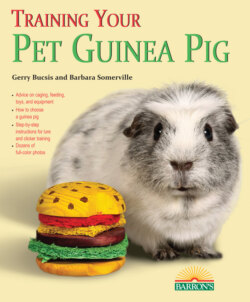Читать книгу Training Your Guinea Pig - Gerry Bucsis - Страница 19
На сайте Литреса книга снята с продажи.
Bedding basics
ОглавлениеBefore popping your cavies into their new home, you need to cover the bottom of the cage with some sort of flooring or bedding, because the plastic floor of a cage is not guinea pig friendly. It’s not soft enough for your pets to walk on or sleep on, and it won’t absorb your guinea pigs’ urine. So, before going any further, you have some bedding decisions to make.
Unfortunately, where guinea pigs are concerned, bedding basics are not so basic! There are lots of choices out there, and it might take some trial and error on your part to find out what works best for you and your piggies.
You shouldn’t even consider some of the bedding products that are available. For example, stay away from cedar, pine, sawdust, cat litter, corn cob, straw, and newspaper. Cedar and pine contain phenols that can cause liver and respiratory problems in small animals. Sawdust and cat litter are too dusty. Corncob bedding and straw get moldy quickly; neither absorbs urine or controls odor well, and some guinea pigs eat corncob bedding. Newspaper used by itself is a very poor choice—it gets wet from urine and stays wet.
So what should you use? Wood pulp fiber is one of the most popular choices because it’s soft and fluffy—comfy for your cavy to walk on and cozy for it to sleep on. It’s also good for absorbency and odor control. However, it’s fairly expensive. Paper pellets are a bit cheaper, but your cavy won’t find them as comfortable as the fluffy stuff. Hardwood pellets, such as aspen, are another possibility. For a cheaper option, you could look for bulk hardwood stove pellets–just make sure they don’t have any chemical additives. Any of these wood pellets are good for absorbency and odor control, but like paper pellets, they’re a bit lacking in the comfort department. Hardwood shavings are softer, but they’re messier and less absorbent.
Some owners find that they get the best results by using two layers of commercial bedding. For example, they might put aspen pellets on the bottom of the cage for absorbency and top these with a layer of wood pulp fiber or hay for comfort.
Since guinea pigs need large cages, the cost of packaged bedding can really add up over time. Nowadays, lots of guinea pig owners are getting away from packaged pet bedding and are using fabric instead. Non-pilling polyester fleece—the thicker the better—is the fabric of choice because it’s soft and wicks away pet urine. Some people buy a piece just large enough to cover the coroplast floor of the cage. Other people buy a piece big enough to go up and over the sides as well. Then, they secure the fleece to the sides with binder clips to keep it in place.
Fleece by itself doesn’t make a good fabric floor; you also need a layer of material under the fleece to absorb the wicked-away urine. There are lots of different absorbent materials you can use, such as thick cotton towels, microfiber towels, washable hospital pads, washable or disposable pet/puppy pads, waterproof crib pads, or thick layers of polyester quilt batting. You could also go to a fabric shop and buy some waterproof mattress padding by the yard. You can even layer a couple of different materials for maximum absorbency and odor control. For example, if you put folded towels under the fleece, and washable hospital pads under the towels, your guinea pigs’ environment will stay super dry.
Another convenient option is to buy one of the ready-made triple-layered bedspreads that are specially designed to fit the coroplast trays of C&C cages. Or, you can buy one of the fitted fleece sheets made for C&C cages and provide your own absorbent material for underneath the fleece. These colorful bedspreads and sheets can also be custom-made for odd-sized cages.
A fleece floor is cozy and comfy.
Although the initial cost of fabric bedding can be fairly high, most of this bedding is washable and reusable, so over time it will be a lot cheaper than the throw-away commercial pet bedding. Be sure to wash the fleece three or four times before using it so that it becomes soft and absorbent. When it’s cleanup time, shake off or vacuum up the feces and hair, then machine wash the bedding in hot water, using scent-free detergent and a little vinegar, but no fabric softener–fabric softener reduces absorbency. Then tumble dry without dryer sheets. To avoid excessive static, remove the fleece from the dryer while it is still slightly damp, and let it air dry. Here’s a handy hint: it’s a good idea to buy a larger piece of fabric than you need, because hot water and the hot air of a dryer can sometimes shrink the fleece.
How often will you need to wash the bedding? This depends on how many guinea pigs you have and how sensitive your nose is!
